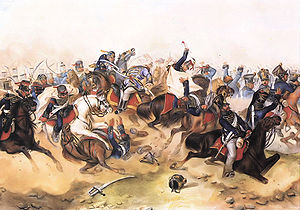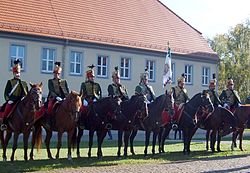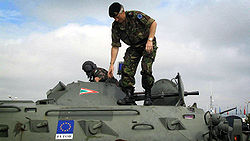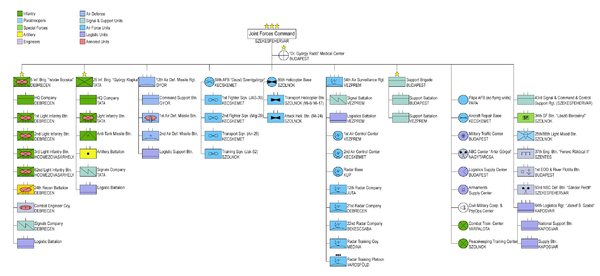- Military of Hungary
-
Hungarian Defence Force
Magyar Honvédség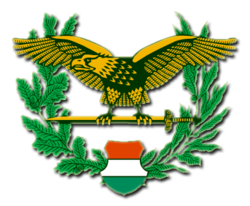
Coat of arms of HonvédségFounded 1848 Current form 1990 Service branches Hungarian Ground Forces
Hungarian Air ForceHeadquarters Budapest Leadership Commander-in-Chief Pál Schmitt, president of Hungary Minister of Defense Csaba Hende Chief of staff General Tibor Benkő Manpower Military age 18 Conscription No (Suspended on 2004) Available for
military service2,380,381[1], age 17–49 Fit for
military service1,884,232[1], age 17–49 Reaching military
age annually58,894[1] Active personnel 26,000 (2010)[2] Reserve personnel N/A Expenditures Budget $1.47 billion (2011)[3] Percent of GDP 0.92% 2011 est. Industry Foreign suppliers  Sweden
Sweden
 Russia
Russia
 United States
United States
 France
France
 Israel
IsraelThe Hungarian Defence Force (Hungarian: Magyar Honvédség) is the national military of Hungary. It currently has two branches, the Hungarian Ground Force and the Hungarian Air Force.
The term "Home Defence Force" was originally used to refer to the armed forces established by Lajos Kossuth and the National Defence Committee of the Revolutionary Hungarian Parliament during the Hungarian Revolution of 1848. In accordance with the Austro-Hungarian Compromise of 1867, the Hungarians were allowed to have their own forces for homeland defence adjunct to and integrated with the standing Imperial and Royal Army. The Honvédség became a specifically Hungarian Army within the Austro-Hungarian Empire.
The term Honvédség is the name of the Hungarian military since 1848 referring to its purpose ("Hon" meaning "homeland" and "véd" meaning "defender" or "defence" thence "Honvéd" meaning "Homeland Defence"). The Hungarian Army is called Magyar Honvédség. The rank equal to a Private is a Honvéd.
Contents
Name
Honvédség is the name of the Hungarian army. It literally means corps of homeland defenders and was originally used to refer to the revolutionary army established by Lajos Kossuth and the National Defence Committee of the Revolutionary Hungarian Diet in September 1848 during the Hungarian Revolution. In accordance with the Austro-Hungarian Compromise of 1867, the Hungarians were allowed to have their own forces for homeland defence integrated within the Imperial Forces. The Honvédség became a specifically Hungarian army within the Austro-Hungarian Empire, distinct from the Austrian Landwehr and the Imperial and Royal (K.u.K.) army of the empire as a whole.
The term Honvédség continued to be the name of the Hungarian military after the end of World War I and the dissolution of the empire. The Hungarian army is still called Magyar Honvédség to this day, and the rank equal to private is honvéd.
This term is also used in the name of the Hungarian football club, Budapest Honvéd FC, originally the army football team.
History
Ancient, medieval, and early modern military
Main articles: Kingdom of Hungary in the Middle Ages, Ottoman Hungary, Royal Hungary, and TransylvaniaThe Hungarian tribes of Árpád vezér who came to settle in the Carpathian Basin were noted for their fearsome light cavalry, which conducted frequent raids throughout much of Western Europe (as far as present-day Spain), maintaining their military supremacy with long range and rapid-firing reflex bows. Not until the introduction of well-regulated, plate-armored knight heavy cavalry could German emperors stop the Hungarian armies.
During the Árpáds the light cavalry based army was transformed slowly into a western-style one. The light cavalry lost its privileged position, replaced by a feudal army formed mainly from heavy cavalry.
The Hungarian field armies were drawn up into an articulated formation (as it happened in Battle of Przemyśl- 1099, Battle at Leitha- 1146, Battle of Morvamezo- 1278, 1349), in three main battle (formation) (1146, 1278, 1349). According to the contemporary sources and later speculations, the first line was formed by light cavalry archers (Battle of Oslava- 1116, 1146, 1260, 1278). Usually they started the battle followed by a planned retreat (1116, 1146, Battle of Kroisennbrunn- 1260). The major decisive battles of the Hungarian army were placed in the second or third lines consisted mainly of the most valuable parts of the army - in general heavy cavalry (1146, 1278, 1349).
The commanders of the Hungarian Kingdom's army used different tactics, based on a recognition of their own and the enemies' (Holy Roman Empire, Pechenegs, Uzes, Cumans, Mongols, Byzantine Empire) abilities and deficiencies.
The Hungarian knight army had its golden age under King Louis the Great, who himself was a famed warrior and conducted successful campaigns in Italy due to family matters (his younger brother married Joan I, Queen of Naples who murdered him later.) King Matthias Corvinus maintained very modern mercenary-based royal troops, called the Black Army. King Matthias favoured ancient artillery (catapults) as opposed to cannons, which were the favourite of his father, Johannes Hunyadi, former Regent of Hungary.
During the Ottoman invasion of Central Europe (between late 14th century and circa 1700) Hungarian soldiers protected fortresses and launched light cavalry attacks against the Turks (see Hungarian Hussars). The northern fortress of Eger was famously defended in the autumn of 1552 during the 39 day Siege of Eger against the combined force of two Ottoman armies numbering circa 120,000 men and 16 ultra-heavy siege guns. The victory was very important, because two much stronger forts of Szolnok and Temesvár had fallen quickly during the summer. Public opinion[citation needed] attributed Eger's success to the all-Hungarian garrison, as the above two forts have fallen due to treason by the foreign mercenaries manning them. In 1596, Eger fell to the Ottomans for the same reason.
In the 1566 Battle of Szigetvár, Miklós Zrínyi defended Szigetvár for 30 days against the largest Ottoman army ever seen up to that day[citation needed], and died leading his remaining few soldiers on a final suicide charge to become one of the best known national heroes. His great-grandson, Miklós Zrínyi, poet and general became of the better known stratagems of 1660s. In 1686, the capital city Buda was freed from the Ottomans by an allied Christian army composed of Austrian, Hungarian, and Western European troops, each roughly one third of the army.[citation needed] The Habsburg then annexed Hungary.
Habsburg Hungarian military
Under Habsburg rule, Hungarian Hussars rose to international fame and served as a model for light cavalry in many European countries. During the 18th and 19th centuries hundreds of thousands of forcibly enrolled Hungarian males served 12 years or more each as line infantry in the Austrian Imperial Army.
Two independence wars interrupted this era, that of Prince Francis II Rákóczi between 1703 and 1711 and that of Lajos Kossuth in 1848–1849. A July 11th, 1848 act of parliament in Budapest called for the formation of an army, the Honvéd, of 200,000 which would use the Magyar language of command. It was to be formed around already extant imperial units, twenty battalions of infantry, ten hussar regiments, and two regiments of Székely from the Transylvanian Military Border. They were further joined by eight companies of two Italian regiments stationed in Hungary and parts of the Fifth Bohemian Artillery Regiment.[4]
In 1848–1849 the Honvéd (mostly made up of enthusiastic patriots with no prior military training) achieved incredible successes against better-trained and -equipped Austrian forces, despite the obvious advantage in numbers on the Austrian side. The Winter Campaign of Józef Bem and the Spring Campaign of Artúr Görgey are to this day taught at prestigious military schools around the globe, including at West Point Academy in the United States. Having suffered initial setbacks, including the loss of Budapest, the Honvéd took advantage of the Austrians' lack of initiative and re-formed around the Debreczen-based Kossuth government.[5] The Hungarians advanced again and by the end of spring 1849, Hungary was basically cleared of foreign forces, and would have achieved independence, were it not for the Russian intervention. At the request of the Austrian emperor Franz Josef,[6] the Russians invaded with a force of 190.000 soldiers - against the Honvéd's 135.000 - and decisively defeated Bem's Second Army in Transylvania, opening the path into the heart of Hungary. This way the Austrian-Russian coalition outnumbered Hungarian forces 3:1, which led to Hungary's surrender at Világos on August 13, 1849. Sándor Petőfi, the great Hungarian poet, went missing in action in the Battle of Segesvár, against invading Russian forces.
In April 1867, the Austro-Hungarian Empire was established. Franz Josef, the head of the ancient Habsburg dynasty, was recognized as both Emperor of Austria and King of Hungary. Nevertheless, the issue of what form the Hungarian military would take remained a matter of serious contention between Hungarian nationalists and Austrian leaders.[7] As the impasse threatened the political union, Emperor Franz Josef ordered a council of generals in November of the same year. Ultimately, the leaders resolved on the following solution: in addition to the joint (k.u.k.) army, Hungary would have its own defense force, whose members would swear their oath to the King of Hungary (who was also Emperor of Austria) and the national constitution, use the Hungarian language of command, and display their own flags and insignia. (Austria would also form its own parallel national defense force, the Landwehr.)[8] As a result of these negotiations, on 5 December 1868, the Royal Hungarian Army (Magyar Kiralyi Honvedseg, or Defense Force) was established.
The Honvédség was usually treated generously by the parliament in Budapest.[9] By 1873 it already had over 2,800 officers and 158,000 men organized into eighty-six battalions and fifty-eight squadrons. In 1872, the Ludovika Academy officially began training cadets (and later staff officers). Honvédség units engaged in maneuvers and were organized into seven divisions in seven military districts. While artillery was not allowed, the force did form batteries of Gatling guns in the 1870s.[10]
In the midst of trouble between the imperial government and the parliament in 1906, the Honvédség was further expanded and finally received its own artillery units. In this form, the force approached the coming world war in most respects as a truly "national" Hungarian army.[11]
World War I
Hungarian soldiers "fought with distinction" on every front contested by Austria-Hungary in the First World War.[11] Honvédség units (along with the Austrian Landwehr) were considered fit for front line combat service and equal to those of the joint k.u.k. army.[12] They saw combat especially on the Eastern Front and at the Battles of the Isonzo on the Italian Front. Out of the eight million men mobilized by Austria-Hungary, over one million died. Hungarians as a national group were second only to German Austrians in their share of this burden, experiencing twenty-eight war deaths for every thousand persons.[13]
After the collapse of the Austro-Hungarian empire in late 1918, the Red Army of the Hungarian communist state (Hungarian Soviet Republic) conducted successful campaigns to protect the country's borders. However, in the Hungarian–Romanian War of 1919 Romanian troops eventually crushed the communists in the spring of 1919, notably at the Battle of Tisza. Hungary came under occupation by Romanian, Serbian, American, and French troops.
In accordance with the Treaty of Bucharest, upon leaving, the Romanian army took substantial compensation for reparations. This included agricultural goods and industrial machinery as well as raw materials.[14] The Trianon Treaty limited the Hungarian Army to 35,000 men and forbad conscription. The army was forbidden to possess tanks, heavy armor, and an air force.
Mid-twentieth century
On 9 August 1919, Admiral Miklós Horthy united various anti-communist military units into a 25,000-strong National Army (Nemzeti Hadsereg). On 1 January 1922, the National Army was once again redesignated the Royal Hungarian Army.
During the 1930s and early 1940s, Hungary was preoccupied with the regaining the vast territories and huge amount of population lost in the Trianon peace treaty at Versailles in 1920. This required strong armed forces to defeat the neighbouring states and this was something Hungary could not afford. Instead, the Hungarian Regent, Admiral Miklós Horthy, made an alliance with German dictator Adolf Hitler's Third Reich. In exchange for this alliance and via the Vienna Awards, Hungary received back parts of its lost territories from Yugoslavia, Romania, and Czechoslovakia. Hungary was to pay dearly during and after World War II for these temporary gains.[citation needed][clarification needed]
On 5 March 1938, Prime Minister Kálmán Darányi announced a rearmament program (the so-called Győr Programme, named after the city where it was announced to the public). Starting 1 October, the armed forces established a five-year expansion plan with Huba I-III revised orders of battle. Conscription was introduced on a national basis in 1939. The peacetime strength of the Hungarian Army grew to 80,000 men organized into seven corps commands.[15]
In March 1939, Hungary launched an invasion of the newly formed Slovak Republic. Both the Royal Hungarian Army and the Royal Hungarian Air Force fought in the brief Slovak-Hungarian War. This invasion was launched to reclaim a part of the Slovakian territory lost after World War I.
On 1 March 1940, Hungary organized its ground forces into three field armies. The Hungarian Army fielded the Hungarian First Army, the Hungarian Second Army, and the Hungarian Third Army. With the exception of the independent "Fast Moving Army Corps" (Gyorshadtest), all three Hungarian field armies were initially relegated to defensive and occupation duties within the regained Hungarian territories.
World War II
Main article: Hungary during the Second World WarIn November 1940, Hungary signed the Tripartite Pact and became a member of the Axis with Nazi Germany and Fascist Italy.
In April 1941, in order to regain territory, Hungary joined the Germans in the invasion of Yugoslavia.
After the controversial Kassa attack, elements of the Hungarian Army joined the German invasion of the Soviet Union, Operation Barbarossa. In the late summer of 1941, the Hungarian "Rapid Corps" (Gyorshadtest), alongside German and Romanian army groups, scored a huge success against the Soviets at the Battle of Uman. A little more than a year later and contrasting sharply with the success at Uman, was the near total devastation of the Hungarian Second Army on banks of the Don River in December 1942 during the Battle for Stalingrad.
During 1943, the Hungarian Second Army was re-built. In late 1944, as part of Panzerarmee Fretter-Pico, it participated in the destruction of a Soviet mechanized group at the Battle of Debrecen. But this proved to be a Pyrrhic victory. Unable to re-build again, the Hungarian Second Army was disbanded towards the end of 1944.
To keep Hungary as an ally, the Germans launched Operation Margarethe and occupied Hungary in March 1944. However, during the Warsaw Uprising, Hungarian troops refused to participate.[16]
Graves of a Hungarian honvéd captain and 6 of his men who fell, fighting on the Polish side in Warsaw uprising 1944
On 15 October 1944, the Germans launched Operation Panzerfaust and forced Horthy to abdicate. Pro-Nazi Ferenc Szálasi was made Prime Minister by the Germans.
On 28 December 1944, a provisional government under the control of the Soviet Union was formed in liberated Debrecen with Béla Miklós as its Prime Minister. Miklós was the commander of the Hungarian First Army, but most of the First Army sided with the Germans and most of what remained of it was destroyed about 200 kilometers north of Budapest between 1 January and 16 February.. The pro-Communist government formed by Miklós competed with the pro-Nazi government of Ferenc Szálasi. The Germans, Szálasi, and pro-German Hungarian forces loyal to Szálasi fought on. On 20 January 1945, representatives of the provisional government of Béla Miklós signed an armistice in Moscow. But forces loyal to Szálasi still continued to fight on.
The Red Army, with assistance from Romanian army units, completed the encirclement of Budapest on 29 December 1944 and the Siege of Budapest began. On 2 February 1945, the strength of the Hungarian Army was 214,465 men, but about 50,000 of these had been formed into unarmed labor battalions.[16] The siege of Budapest ended with the surrender of the city on 13 February. But, while the German forces in Hungary were generally in a state of defeat, the Germans had one more surprise for the Soviets.
In early March 1945, the Germans launched the Lake Balaton Offensive with support from the Hungarians. This offensive was almost over before it began. By 19 March 1945, Soviet troops had recaptured all the territory lost during a 13-day German offensive.[17]
After the failed offensive, the Germans in Hungary were defeated. Most of what remained of the Hungarian Third Army was destroyed about 50 kilometers west of Budapest between 16 March and 25 March 1945. Officially, Soviet operations in Hungary ended on 4 April 1945 when the last German troops were expelled.
Some pro-fascist Hungarians like Szálasi retreated with the Germans into Austria and Czechoslovakia. During the very last phase of the war, Fascist Hungarian forces fought in Vienna, Breslau, Küstrin, and along the Oder River.[16]
On 7 May 1945, General Alfred Jodl, the German Chief of Staff, signed the document of unconditional surrender for all German forces. Jodl signed this document during a ceremony in France. On 8 May, in accordance with the wishes of the Soviet Union, the ceremony was repeated in Germany by Field Marshal Wilhelm Keitel. On 11 June, the Allies agreed to make 9 May 1945 the official "Victory in Europe" day.[18] Szálasi and many other pro-fascist Hungarians were captured and ultimately returned to Hungary's provisional government for trial.
Warsaw Pact
During the Socialist and the Warsaw Pact era (1955–1989), the entire 200,000 strong Southern Group of Forces was garrisoned in Hungary, complete with artillery, tank regiments, air force and missile troops (with nuclear weapons). It was by all means a very capable force that made little contact with the local population. Between 1949 and 1955 there was also a huge effort to build a big Hungarian army. All procedures, disciplines, and equipment were exact copies of the Soviet Red Army in methods and material, but the huge costs collapsed the economy by 1956.
After the autumn 1956 revolution was crushed in Budapest, the Soviets took away most of the Hungarian Army's equipment. A few years later, when offered a choice of withdrawal, the new Hungarian leader János Kádár asked for all the 200,000 Soviet troops to stay, because it allowed the socialist Hungarian People's Republic to neglect its own draft-based armed forces, quickly leading to deterioration of the military. Large sums of money were saved that way and spent on feel-good measures for the population, thus Hungary could become "the happiest barrack" in the Soviet Bloc.
Training for army conscripts was poor and most of those drafted were actually used as a free labour force (esp. railway track construction and agricultural work) after just a few weeks of basic rifle training. Popular opinion grew very negative towards the Hungarian Army and most young men tried to avoid the draft with bogus medical excuses.
Current military
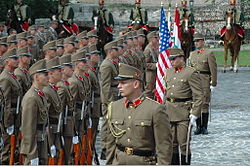 Hungarian Ground Forces welcome the President of the United States. Mounted hussars can be seen along the top.
Hungarian Ground Forces welcome the President of the United States. Mounted hussars can be seen along the top. The Hungarian Air Force has 14 JAS 39 Gripens on lease, including two two-seaters (C/D versions). The final three aircraft were delivered in December 2007.
The Hungarian Air Force has 14 JAS 39 Gripens on lease, including two two-seaters (C/D versions). The final three aircraft were delivered in December 2007.
Command structure
Since 2007, the Hungarian Defense Forces is under a unified command structure. The Ministry of Defence maintains the political and civil control over the army. The military leadership is exercised by the Defense Staff of the Ministry of Defense. A subordinate Joint Forces Command is coordinating and commanding the HDF corps.
Structure of modern day Hungarian Defence Forces
Administrative support
- HDF Military Administrative and Data Processing Centre
- HDF Augmentation / Recruitment Commands
- HDF Western Hungarian Augmentation / Recruitment Command
- HDF Eastern Hungarian Augmentation / Recruitment Command
- HDF Operations Centre
- NATO/EU positions
Combat
- HDF 5th ‘István Bocskai’ Infantry Brigade
- HDF 25th ’György Klapka’ Infantry Brigade
- HDF 25/88th Light Mixed Battalion
- HDF 34th ’László Bercsényi’ Special Operations Battalion
- HDF 59th ’Dezsõ Szentgyörgyi’ Aviation Base
- HDF 12th Arrabona Anti Aircraft Missile Regiment
- HDF 86th Szolnok Helicopter Base
Combat support
- MH 37th ’Ferenc Rákóczi II’ Engineering Regiment
- HDF 93rd ’Sándor Petõfi’ NBC Battalion
- HDF 43rd Signal and Command and Control Support Regiment
- HDF 54th Veszprém Air Surveillance Regiment
- HDF Civilian–Military Cooperation and
- Psychological Operations Centre
- HDF ‘Artúr Görgei’ NBC Information Centre
- HDF Peace Support Training Centre
- HDF Military Transport Centre
- HDF 1st Honvéd Explosive Ordnance Disposal and Warship Regiment
Service – Support
- HDF 64th ’József Boconádi Szabó’ Logistics Regiment
- HDF Bakony Combat Training Centre
- HDF Pápa Base Airport
- HDF Hazardous Material Supply Centre
- HDF Logistics Supply Centre
- HDF Aircraft Repair Plant
- HDF Military Transport Centre
- HDF Support Brigade
- HDF Geoinformation Service
- HDF ’Dr György Radó’ Honvéd Medical Centre
- HDF Central Training Base and HDF ‘Pál Kinizsi’
- NCO Training School Szentendre
Missions
- HDF Special Operation Team Afghanistan - objectives: Recon and Support (The hungarian Government hands it in top secret)
- HDF Mi-17 Air Mentoring Team Afghanistan
- HDF Mi-35 Air Mentoring Team Afghanistan
- HDF Operational Mentoring and Liaison Team Afghanistan
- HDF Provincial Reconstruction Team, Afghanistan
- HDF EUFOR Althea Contingent, Bosnia and Herzegovina
- HDF UNFICYP Contingent, Cyprus and specific other missions.
The Hungarian armed forces have severely reduced the number of battle tanks in service and surplussed all tracked IFV's. A large number of garrisons were shut down, some of them sold to municipal authorities for peaceful uses.
In 1997, Hungary spent about 123 billion HUF ($560 million) on defense. Hungary became a member of NATO on March 12, 1999. Hungary provided airbases and support for NATO's air campaign against Serbia and has provided military units to serve in Kosovo as part of the NATO-led KFOR operation. Hungary has sent a 300 strong logistics unit to Iraq in order to help the US occupation with armed transport convoys, though public opinion opposed the country's participation in the war. One soldier was killed in action due to a roadside bomb in Iraq. The parliament refused to extend the one year mandate of the logistics unit and all troops have returned from Iraq as of mid-January 2005. Hungarian troops are still in Afghanistan as of early 2005 to assist in peace-keeping and de-talibanization. Hungary will most probably replace its old GAZ 4x4 vehicles with the modern Iveco LMV types. Hungarian forces deploy the Gepárd anti-materiel rifle, which is a heavy 12,7 mm portable gun. This equipment is also in use by the Turkish and Croatian armed forces, among other armies.
New transport helicopter purchases are on the list before. Most probably this will happen before 2015.
In a significant move for modernization, Hungary decided in 2001 to buy 14 JAS 39 Gripen fighter aircraft (the contract includes 2 dual-seater airplanes and 12 single-seaters as well as ground maintenance facilities, a simulator, and training for pilots and ground crews) for 210 billion HUF (about 800 million EUR). Five Gripens (3 single-seaters and 2 two-seaters) arrived in Kecskemét on March 21, 2006, expected to be transferred to the Hungarian Air Force on March 30. 10 or 14 more aircraft of this type might follow up in the coming years.
Equipment
See also
References
- ^ a b c https://www.cia.gov/library/publications/the-world-factbook/geos/hu.html
- ^ http://www.state.gov/r/pa/ei/bgn/26566.htm
- ^ http://www.politics.hu/20091207/hungarys-defense-spending-to-rise-next-year-reach-12-billion
- ^ Rothenburg, G. The Army of Francis Joseph. West Lafayette: Purdue University Press, 1976. p 29.
- ^ Rothenburg 1976, p. 32-33.
- ^ Rothenburg 1976, p. 35.
- ^ Rothenburg 1976, p. 75-76.
- ^ Rothenburg 1976, p. 77.
- ^ Rothenburg 1976, p. 78.
- ^ Rothenburg 1976, p. 85.
- ^ a b Rothenburg 1976, p. 136.
- ^ Rothenburg 1976, p. 173.
- ^ Rothenburg 1976, p. 218.
- ^ [1]
- ^ Page 207, Mollo, Andrew, The Armed Forces of World War II, Crown, 1981, New York, ISBN 0-517-54479-4
- ^ a b c Page 208, Mollo, Andrew, The Armed Forces of World War II, Crown, 1981, New York, ISBN 0-517-54479-4
- ^ Page 182, The Decline and Fall of Nazi Germany and Imperial Japan, Hans Dollinger, Library of Congress Catalogue Card Number 67-27047
- ^ Page 298, The Decline and Fall of Nazi Germany and Imperial Japan, Hans Dollinger, Library of Congress Catalogue Card Number 67-27047
External links
- On-line magazin of Hungarian Ministry of Defence
- The homepage of the Hungarian Ministry of Defence
- Magyar Tudomány 2000. január
North Atlantic Treaty Organization (NATO) History 
Structure Members Militaries of the member states of the European Union Military of Europe Sovereign
states- Albania
- Andorra
- Armenia
- Austria
- Azerbaijan
- Belarus
- Belgium
- Bosnia and Herzegovina
- Bulgaria
- Croatia
- Cyprus
- Czech Republic
- Denmark
- Estonia
- Finland
- France
- Georgia
- Germany
- Greece
- Hungary
- Iceland
- Ireland
- Italy
- Kazakhstan
- Latvia
- Liechtenstein
- Lithuania
- Luxembourg
- Macedonia
- Malta
- Moldova
- Monaco
- Montenegro
- Netherlands
- Norway
- Poland
- Portugal
- Romania
- Russia
- San Marino
- Serbia
- Slovakia
- Slovenia
- Spain
- Sweden
- Switzerland
- Turkey
- Ukraine
- United Kingdom
- Vatican City
States with limited
recognition- Abkhazia
- Kosovo
- Nagorno-Karabakh
- Northern Cyprus
- South Ossetia
- Transnistria
Other entities - European Union
- Sovereign Military Order of Malta
 Hungary topics
Hungary topicsHistory Prehistory · Pannonia · Medieval Kingdom of Hungary · Habsburg Kingdom of Hungary · Austria-Hungary · World War I · Between the World Wars · World War II · The People's Republic
Geography Governance Politics Economy Companies · Hungarian forint · Hungarian National Bank · Telecommunications · Tourism · Transport · HealthcareSociety Culture Categories:
Wikimedia Foundation. 2010.


